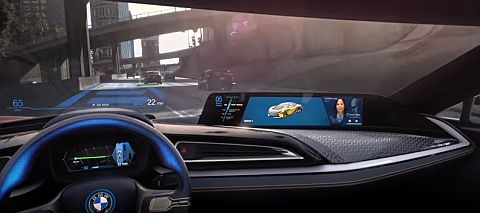
The dashboard of the BMW’s latest concept car, BMW i8, uses AI to mitigate miscommunication between a driverless car and its passengers.
Youtube/carjam TV/FJORDS TREND 2018
How businesses can cope with changes that AI will bring to IT-BPM sector
The importance of collaboration between people and machines is cited amid the growing trend of artificial intelligence (AI) and how it can affect the Information Technology-Business Process Management (IT-BPM) sector across the globe.
Wilfredo Sa-a Jr., managing director at the Cebu IT-BPM Organization (CIB.O), said on the higher scale, AI would be a big thing and collaboration with machines would be important.
“Industries and businesses, aside from being technology-driven, should also be AI-enriched,” Sa-a said in a text message to Cebu Daily News.
He added that jobs for people would become more complex as simple tasks would be automated, further saying that new jobs should be about how man and machine should work together.
Sa-a said that on the lower level, there is a need for local government units and small businesses to embrace digital technology.
“It will be for faster, more efficient, and transparent services in the private and public sector,” he said.
The Philippine IT-BPM industry targets to grow its workforce to 1.8 million by 2022 from 1.15 million as of end-2016, but Sa-a said they project a slower employment growth in the coming years with AI already factored in.
Fjord Trends 2018 reax
Sa-a was reacting to the insight presented by management consulting company, Accenture in Fjord Trends 2018, a report that examines trends expected to impact business, technology, and design in the year to come.
“We can – and should – design our collaboration with the machines that will help us develop,” the report said.
Accenture pointed out that the rise of AI and robots had replaced the “threat” production lines, typewriters, and motorized vehicles had brought back then.
While the implications of AI cut across industries, it has become a particularly hot topic among stakeholders of the Information Technology-Business Process Management (IT-BPM) sector across the globe, especially with predictions that it will eventually wipe out simple tasks and place the jobs of thousands of workers in peril.
AI, change, jobs
However, Accenture said organizations must stop talking about it and start designing for this change by coming to terms with how to enable people and machines to get the best out of each other.
According to the report, concern had been growing about the jobs robots might take over or make obsolete, but the rise of the robots had not accurately reflect the true impact AI and machine learning would have on the workplace.
For a start, while some jobs would be replaced, new jobs would be created, Accenture said.
New jobs created
In a recent global study, Accenture identified several new categories of jobs — Trainers, Explainers and Sustainers — where people will complement the tasks performed by cognitive technology, which the rise of machines will create.
Furthermore, realization is growing that machines are becoming, in the words of Fjord designer Paige Maguire, “another type of user.”
“Focus is shifting onto the potential for looking beyond any potential competition between people and machines to harness their combined strengths,” Accenture said.
DTI-Cebu exec’s reax
Maria Elena Arbon, provincial director at the Department of Trade and Industry (DTI) in Cebu, agreed with the points laid down by Accenture.
For Arbon, AI would enhance people’s ability to analyze and make decisions, use their imagination, as well as to be more creative and innovative.
“In the short term, jobs that are routine in nature will be lost to AI but then it will free us or give us the time to pursue more meaningful endeavors,” she said.
Arbon shared that the trick would be for humans to keep moving forward, learn new skills, learn to deal with change which would be coming at a faster rate than they would be used to.
Agri and AI
The trade official cited agriculture as an example of areas where AI technologies could be used more for greater efficiency and productivity.
“Sensors and the data they can generate can go a long way to supporting our farmers make better decisions, but of course, the agri sector has to level up to understand and apply these technologies,” Arbon said.
Cancer experiments
In its latest report, Accenture cited a Harvard-based team which recently came up with an AI method that could identify cancer cells with 92-percent accuracy.
In their experiment, pathologists beat the machines by achieving 96 percent accuracy.
When they worked together, however, the combined forces of human pathologists and AI accurately identified 99.5 percent of cancerous biopsies, showing how AI and people are at their best when they collaborate.
“In light of this development, organizations must act now to reimagine the working experience,” Accenture said.
The firm further said in its report that machine and human coexistence would need to be rethought and designed for now.
Accenture said adjusting to this new workplace would be a massive design challenge, and understanding the best ways to harness AI and EQ (emotional intelligence) would be a priority.
BMW example
BMW is already setting a powerful example, according to the management firm.
The report stated that one of BMW’s latest concept cars is designed to mitigate miscommunication with driverless vehicles by building a pseudo-relationship between the car and its passengers to make them feel safe when being driven around by a machine.
Accenture encouraged organizations to pool collective ingenuity, intelligence, and relentless optimism to invent new ways for AI to amplify human capabilities.
“The key is to plan for a future in which people and machines work collaboratively,” it added.